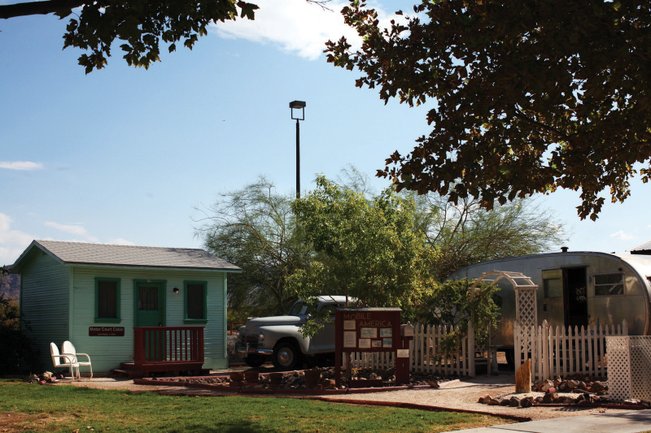From our good pal Kristen Peterson at the Las Vegas Sun:
In the Las Vegas Valley, saving historic buildings and artifacts often involves moving them

Tiffany Brown
Motor Court Cabin, left, originally in Las Vegas, is now on Heritage
Street at the Clark County Museum, which features rescued historic
houses from throughout the area.
By Kristen Peterson
Thu, Oct 2, 2008 (2 a.m.)
Las Vegas is always about the next big thing — and a move-it-or-lose-it attitude that pummels the city’s past.
Sometimes we move it. Sometimes we lose it. What’s interesting is
when “moving it” means creating another themed attraction by extracting
our past from the present and sequestering it.
If preservationists had any sense, they would require developers to
replicate today’s buildings and place the doppelganger on the outskirts
of town, saving time and money on future historical rescue operations.
A lot of money has been spent on saving the significant works
sitting in the popular Neon Boneyard. The rescue of the Stardust sign
cost $200,000. Moving the La Concha lobby, one of Las Vegas’ most
famous pieces of Googie architecture, from the Strip cost $1.4 million.
Then there is Heritage Street, a tidy tree-lined stretch of gravel
road outside the Clark County Museum on Boulder Highway that includes
houses and notable buildings from the Las Vegas Valley’s past. Rescued
by groups desperate to save Southern Nevada’s disappearing history, the
buildings were plunked down in Henderson, restored, decorated and
opened to the public. Moving and restoring the homes has come at a
hefty price.
The permanent exhibit is a brilliant slice of 20th-century American
life, a nice getaway for anyone lamenting the Mediterranean-themed,
master-planned communities sprawling across the valley. You can sit on
a bench outside the print shop or on the front porch of the Beckley
House, a California bungalow built in 1912 for the Beckley family,
which owned a clothing store in downtown Las Vegas.
These aren’t replicas. They’re the real deal — filled with authentic
furniture, dishes, wall hangings, knickknacks, historical tidbits and
recorded music. Each is its own period piece. There is a motor court
cabin from the 1930s and the Boulder City Railroad Depot.
Call it a nod to creative preservation in a progressive area.
Themed attractions have made Las Vegas famous. Just when we wondered
what would be next, MGM Mirage decides to build the biggest “theme” of
all: an urban core on the Strip, an attraction you might say only
simulates high-rise living with grocery stores within walking
distanced. Eventually, we might tear down CityCenter and replace it
with something else, leaving only a whisper of the Stripside urban
condo community.
Heritage Street, by comparison, has no such glamour. It doesn’t even
have a casino. But it’s a collection that shows where we were and how
far we’ve come.
The Neon Boneyard has international fame, but visitors still drive
down East Fremont Street to look at the dilapidated auto court motels,
many of which have been pillaged.
We lost one of our legendary wedding chapels on the Strip, but the
Las Vegas Convention and Visitors Authority is helping fund the
restoration, along with the State Cultural Commission. Next year is
Clark County’s centennial. The chapel and the Railroad Cottage, both on
the county museum property, are expected to be restored and displayed
by the end of the year.
The Townsite homes, built in the 1940s in Henderson, were meant as
temporary housing for war workers. On the other hand, Myron Martin,
president of the Las Vegas Performing Arts Center Foundation, says the
Smith Center for the Performing Arts is being designed and built to
last 300 years. Whew. That’s something, at least.
In 20 years preservationists might be concerned with the Eiffel
Tower that stood outside Paris Las Vegas during the heyday of
hyperthemed casinos.
Preservationist and historian Bob Stoldal says he’s stood before the
Bellagio and asked himself, “What is this going to be in 50 years?”


